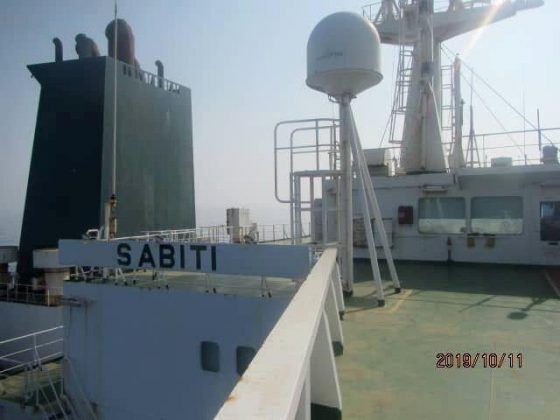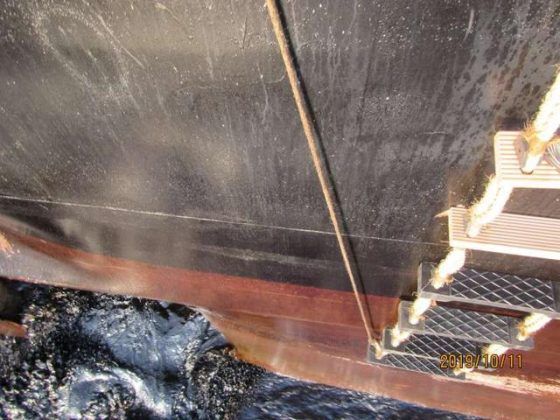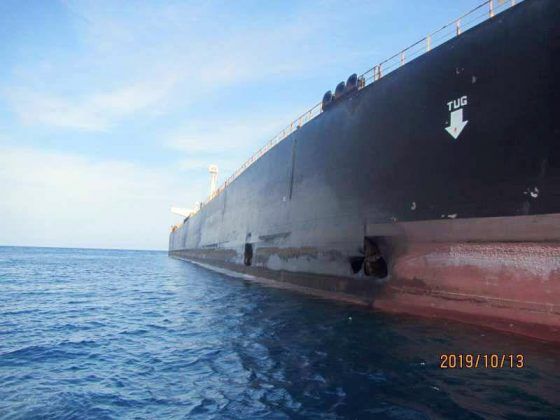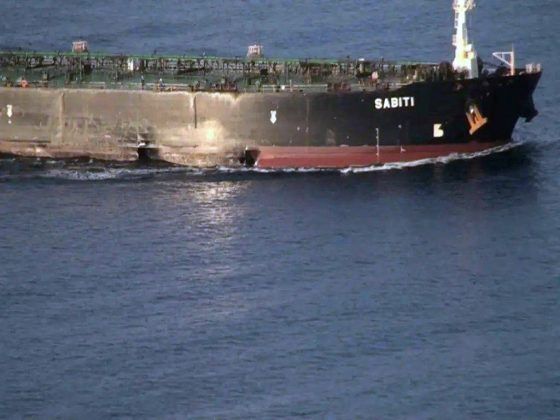The Islamic Republic has released several photographs in recent days which showed gaping holes in the hull of its National Iranian Tanker Company’s (NITC) oil tanker, Sabiti, that Tehran said were caused after two missiles hit the ship as it was traveling northward in the Red Sea, 60 miles off the coast of Jeddah on October 11.
Although no one has claimed responsibility for the alleged attacks, many people suspect it was in retaliation for a series of missiles and drone strikes on Saudi Arabia’s Abqaiq and Khurais oil facilities in the southern part of the country on September 14, which Riyadh, Washington, and most European governments believe was carried out on orders from Tehran.
“The Attack on the Iranian Oil Tanker in Red Sea Was A Stupid Act That Will Not Go Unanswered,” was the front-page headline of the Tehran-based hardline newspaper Kayhan on October 11. “Iranian authorities have launched an investigation to identify the sponsors and the culprits of this terrorist act. The perpetrators will not escape punishment.”
“Iran will avoid a hasty investigation into the explosions,” Ali Rabiei, the spokesman for the Iranian government said during a press conference. “The response to this cowardly act will undoubtedly be proportionate and decisive, but we must first uncover every aspect of this plot.”
“We have identified the masterminds behind this dangerous adventurism,” Rear Admiral Upper Half Ali Shamkhani, the Secretary of the Supreme National Security Council, told the semi-official Fars news agency. “The malicious acts inside international waters aimed at destabilizing commercial shipping will not go unpunished.”
Comments by senior Iranian officials show that the Islamic Revolutionary Guards Corps (IRGC) may launch a new series of attacks on U.S. forces and their allies in the Persian Gulf and the Strait of Hormoz.
The IRGC recently tested a new fleet of unmanned surface vehicles (drone boats) and stealth ships during the Maritime Academy’s 7th National Conference on Fast Crafts 2019 (NCFC 2019) held in Caspian Sea waters near Bandar-e Anzali in the northern province of Gilan.
The enhanced “Ya Mehdi” speed boat is the latest addition to the IRGC Navy. The upgrade reportedly includes a rocket launcher and the capacity to transport explosives, making it a mobile bomb that could inflict severe damage to tankers and aircraft carriers. The boat was first tested in the “Great Prophet-9” military exercises in 2014.
The IRGC may also resort to suicide attacks.
[aesop_image img=”https://kayhanlife.com/wp-content/uploads/2019/07/stena-tanker-909034.jpg” panorama=”off” credit=”FILE PHOTO: A boat of Iranian Revolutionary Guard sails next to Stena Impero, a British-flagged vessel owned by Stena Bulk, at Bandar Abbas port, in this undated handout photo. REUTERS./” align=”center” lightbox=”off” captionsrc=”custom” captionposition=”left” revealfx=”off” overlay_revealfx=”off”]
Recently, the Iranian military revealed a new unmanned aircraft in its fleet that can fly half a meter above water and carry a sizeable payload of bombs. It can fly up to 3,000 feet and take off and land on water. The aircraft could inflict severe damage to vessels.
Senior commanders of the IRGC Navy have said it would take their forces only 50 seconds to destroy a U.S. aircraft carrier.
Given that U.S. sanctions have brought Iran’s economy to the brink of complete collapse, and that there is no hope of renegotiating the 2015 Joint Comprehensive Plan of Action (JCPOA), better known as the Iran nuclear deal, then it is possible that by creating a crisis in the region Tehran hopes to gain some political advantage before it ultimately submits to America’s demands.
Towards the end of the Iran-Iraq War (1980-88), both countries began to target each other’s oil tankers in the Persian Gulf. Iran believed that Kuwait funded Baghdad’s war effort and that the U.S. navy protected Iraqi oil export. Kuwait also allowed Saddam Hussain’s military to use its Shuaiba Port and Ali Al Salem Air Base to transport arms and ammunitions to its fighters and army ground units.
The conflict ultimately escalated into what came to be known as the “Tanker War.”
Kuwait finally asked U.S. President Ronald Reagan to provide naval protection for its oil tankers and commercial shipping. Under “Operation Earnest Will,” the U.S. Navy deployed a massive maritime convoy, which included several warships to the Persian Gulf.
When the founder of the Islamic Republic, the late Ayatollah Ruhollah Khomeini, was briefed about the situation, he reportedly said: “If it were me, I would have attacked the aircraft carriers.”
Iran’s Supreme Leader Ayatollah Ali Khamenei, who was the president of the Islamic Republic (1981-89) during the war, said in a speech: “The Persian Gulf War is not modern warfare. It needs a particular military tactic, namely martyrdom operations. Today, only the Islamic Republic possesses this tactical capability in the region.”
“Martyrdom operations are epic tales that reach the pinnacle of national greatness,” Mr. Khamenei added.
[aesop_image img=”https://kayhanlife.com/wp-content/uploads/2019/10/2019-10-13T123630Z_1536159814_RC1E5E1B6410_RTRMADP_3_IRAN-GUARDS-KHAMENEI.jpg” panorama=”off” credit=”Iran’s Supreme Leader Ayatollah Ali Khamenei attends a graduation ceremony for student officers and guard trainees in Tehran, Iran September 13, 2019. REUTERS./” align=”center” lightbox=”off” captionsrc=”custom” captionposition=”left” revealfx=”off” overlay_revealfx=”off”]
Ultimately, the UN Security Council passed Resolution 598, which called on Iran and Iraq “to observe an immediate ceasefire, discontinue all military actions and withdraw all forces to the internationally recognized boundaries.”
Two days after the UN Security Council ratified Resolution 598, the U.S. Naval vessels escorted supertankers MV Bridgeton (formerly al-Rekkah) and Gas Prince from a port in the United Arab Emirates (UAE) through the Strait of Hormoz.
The MV Bridgeton, however, struck a naval mine and sustained limited damage to its hull. The incident highlighted the danger to commercial shipping-despite U.S. warships patrolling the waterways.
Iran, however, did not take direct responsibility for the attack, claiming that it was “delivered by invisible hands.”
Iran’s then Prime Minister Mir-Hossein Mousavi Khameneh said that the incident “inflicted an irreparable blow to America’s political and military prestige.”
A week later, on August 1, 1987, a large group of Iranian pilgrims began chanting anti-American and anti-Saudi slogans during the annual Hajj pilgrimage in Mecca, Saudi Arabia. The Saudi security police attacked the crowd, killing and wounding hundreds of people.
[aesop_image img=”https://kayhanlife.com/wp-content/uploads/2019/10/حجاج.jpg” panorama=”off” credit=”SOURCE: KAYHAN LONDON” align=”center” lightbox=”off” captionsrc=”custom” captionposition=”left” revealfx=”off” overlay_revealfx=”off”]
Ayatollah Khomeini released a statement three days later saying that “Iran held America directly responsible for these crimes, and God willing, we will respond at the time of our choosing.”
A Silkworm missile struck the Kuwaiti port of Al Ahmadi three days later. Many believe the Islamic Republic was behind the attack.
Texaco Caribbean, a tanker under charter to a U.S. firm, hit a mine in the Gulf of Oman on August 10.
Iranian speed boats also harassed and even attacked British, Kuwaiti, American and Saudi vessels.
The Tanker War was in full swing by this time.
On September 21, U.S. frigate-based MH-6 Army special operations helicopters attacked and captured the Iran Ajr (former Arya Rakhsh), an Iranian landing craft used for covert minelaying, about 50 miles northeast of Bahrain. The U.S. navy special forces found 10 mines aboard the ship. They also rescued 26 Iranians, but another three died in battle, and two were reported missing.
The incident occurred exactly one day before President Khamenei addressed the UN General Assembly in New York. In his speech, Mr. Khamenei said that the sole purpose of Resolution 598 was to pressure Iran.
Years later, Khamenei took the same stance on the JCPOA. He has, however, had to submit to both accords at the end.
The IRGC planned a military “deception” (diversion) operation on September 4, 1987, against Saudi oil fields in Ras Al Khafji, but aborted the plan for various logistical reasons.
Around this time, IRGC’s “evasive” and “diversionary” attacks against foreign ships gradually evolved into “martyrdom operations.”
Nader Mahdavi was the commander of the IRGC’s Zolfaghar Naval Squadron, which carried out an attack on U.S. helicopters on October 8, 1987. An IRGC speed boat crashed into a U.S. helicopter, prompting the U. S. frigate-based MH-6 helicopters to attack four Iranian speedboats about 15 miles southwest of Farsi Island, sinking one and damaging and capturing two. U.S. forces picked up six wounded Iranians from waters, two of whom later died.
On October 15, a Silkworm missile hit and damaged U.S.-owned, Liberian-flagged tanker, Sungari, at Kuwait’s Mina Al-Ahmadi port terminal. The following day, another Silkworm missile hit a re-flagged Kuwaiti tanker, Sea Isle City, near Mina al-Ahmadi, injuring 18 people.
Iran reportedly fired both missiles from Al-Faw Peninsula, 20 kilometers southeast of the Iraqi city of Basra.
In response, U.S. forces launched “Operation Nimble Archer” on October 19, which destroyed Iranian oil platforms Resalat and Reshadat east of Bahrain.
On April 14, 1988, the USS Samuel B. Roberts (FFG-58) entered a minefield in the Persian Gulf, mid-way between Qatar and Iran. Despite the crew’s best efforts and rapid evasive maneuvers, the ship suffered severe damage after a mine with 250 pounds of TNT exploded near its hull.
The U.S. military retaliated by launching “Operation Praying Mantis,” which targeted Nasr and Salmon oil fields within Iran territorial waters.
The Islamic Republic’s military could not, however, match America’s firepower.
The U.S. navy destroyed Iranian cruisers Joshan and Sahand and three-speed boats, and severely damaged an IRGC frigate, Sabalan, killing 60 soldiers. Iran retaliated by shooting down one U.S. Bell AH-1 Cobra helicopter, killing two people on board.
“We received news that America had attacked Joshan and Sahand oil field,” former Iranian president, the late Akbar Hashemi Rafsanjani, wrote in his memoirs. “Iranian forces were ordered to strike the oil platforms in the UAE. The attack sank a U.S. tugboat and set fire to a British oil tanker. Our forces also attacked two other ships. U.S. navy sank one of our missile frigates, killing several sailors.”
Mr. Rafsanjani, who was the Majlis (Iranian Parliament) Speaker (1980-89) during this period warned: “God willing, Iran will use its effective yet invisible forces at its disposal to retaliate if Iraq does not stop its attacks on Iranian oil fields and installations.”
In July 1988, Ayatollah Khomeini finally accepted the UN Security Council Resolution 598, famously describing it as “worse than drinking poison.”
Although the resolution ended the eight-year war between Iran and Iraq, the Islamic Republic did not cease its regional ambitions and efforts to spread its ideology around the world.
The end of the war did not usher in an era of peace and prosperity in the region. It also did not stop global terrorism.
On December 21, 1988, the New York-bound Pan Am Flight 103 exploded in mid-flight, killing all 243 passengers and 16 crew members on board in what later became known as the Lockerbie bombing. Large sections of the aircraft crashed onto residential areas of Lockerbie, Scotland, killing 11 people on the ground, bringing the total number of victims to 270.
After a three-year investigation, authorities indicted two Libyan nationals in November 1991.
Libyan leader Muammar Gaddafi eventually handed the two suspects to the authorities in 1999.
A court in Scotland found Abdelbaset al-Megrahi, a Libyan intelligence officer, guilty of 270 counts of murder and sentenced him to life in prison. The Scottish government, however, released him on compassionate ground in 2009. Al-Meghrahi died of cancer in 2012.
Although he maintained that he had never given the order for the terrorist act, Colonel Gaddafi accepted responsibility for the Lockerbie bombing and paid compensation to the families of the victims in 2003.
According to some estimates, there were 560 attacks on commercial and military ships and aircraft during the first Tanker War, which destroyed many oil tankers and killed and wounded scores of people.
The Tanker War ended on a sad note after the USS Vincennes, a guided-missile cruiser, shot down a passenger plane, Iran Air Flight 655, on July 3, 1988, over Iran’s territorial waters in the Persian Gulf, killing all 290 passengers and crew members on board including 66 children.
Although the regime maintained that the war with Iraq did not impact the sale of its oil, the first Tank War severely impacted the Iranian economy and its oil export. Ultimately, the Iranian people have had to shoulder the exorbitant financial and human cost of the regime’s reckless military ambitions, political adventurism, ideological campaigns, and economic mismanagement.
The recent attacks on commercial oil tankers seem to have triggered a second Tanker War in the Persian Gulf.
A few weeks after two oil tankers, the Panamanian Kokuka Courageous, and Norway’s Front Altair were attacked in the Strait of Hormoz in June 2019, the U.S. and its Western and regional allies launched “Operation Sentinel” to protect commercial shipping in the Persian Gulf.
U.S. President Donald Trump’s comprehensive economic sanctions have reduced Iranian oil exports to zero — something that former U.S. President Ronald Reagan did not do. Mr. Trump has, however, refused to take any military actions against Iran on behalf of Saudi Arabia, the UAE, and other U.S. allies in the region.
Trump did not even retaliate when the IRGC shot down an unmanned U.S. military RQ-4A Global Hawk Bams-D surveillance drone over the Strait of Hormoz on June 20. He instead imposed more economic sanctions on Tehran.
The Islamic Republic could start another war, but the current circumstances differ vastly from those in the 1980s.
The Iranian people supported the regime during the war with Iraq. Also, the military had inherited relatively new and sophisticated weaponry that the late Mohammad Reza Shah Pahlavi had purchased from America.
Forty years on, the Islamic Republic’s old military hardware is no match for the technologically advanced U.S., Saudi Arabia, and Israeli weaponry. Besides, Tehran cannot fund a prolonged armed conflict.
One of the most notable opposition leaders, Reza Pahlavi, has said that the regime would go to great lengths, including starting a war, to ensure its survival. Mr. Pahlavi has, however, pointed out that the people and the international community do not want war, and Iranians should make it known that they do not support a warmongering regime. They should let the Islamic Republic know that it does not have the mandate to create chaos and destabilize the region.
For the regime to fall, it must lose all support, including that of the Iranian people. The leaders of the Islamic Republic know this only too well. There are travel bans on some officials which prevent them from escaping the country if the crisis reaches a boiling point. Others have been spearheading the campaign against corruption to win popular support. Some have been proposing plans to motivate people to vote in the forthcoming Majlis elections. There is also a group of hardcore fanatical ideologues who want to die in a blaze of glory while fighting a final holy war.
[Translated from Persian by Fardine Hamidi]









